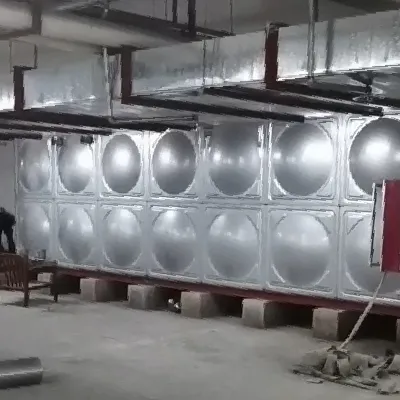loading...
- No. 9, Xingyuan South Street, Dongwaihuan Road, Zaoqiang County, Hengshui, Hebei, China
- admin@zjcomposites.com
- +86 15097380338
- Welcome to visit our website!
molded frp
The Evolution and Benefits of Molded FRP A Comprehensive Overview
Fiber Reinforced Polymer (FRP) is a composite material made from a polymer matrix reinforced with fibers, primarily glass, carbon, or aramid. Among the various forms of FRP, molded FRP has gained prominence in a variety of industries due to its unique advantages and versatility. This article delves into the evolution, manufacturing processes, applications, and benefits of molded FRP.
The Evolution of Molded FRP
The origins of FRP can be traced back to the mid-20th century, wherein engineers and researchers began experimenting with composite materials to create stronger, lighter, and more resilient structures. Molded FRP emerged as a solution to traditional manufacturing constraints, addressing the need for components that could withstand harsh environmental conditions while being lightweight and cost-effective. Over the years, advancements in resin technology and fiber reinforcement have significantly improved the performance characteristics of molded FRP, making it a preferred choice in diverse applications, from aerospace to construction.
Manufacturing Processes
Molded FRP can be produced using various manufacturing techniques, each suited for specific applications and desired characteristics. The most common methods include
1. Hand Layup This traditional method involves manually layering fiberglass mats and applying resin, allowing for customization and small production runs. While labor-intensive, it enables intricate designs.
2. Spray-Up In this technique, a spray gun is used to apply chopped strands of glass fibers and resin simultaneously onto a mold. This is efficient for producing larger components with a consistent finish.
3. Compression Molding In this process, pre-measured amounts of resin and glass fibers are placed in a heated mold, and pressure is applied to form the part. This method is ideal for high-volume production and results in components that exhibit superior strength and surface quality.
4. Pultrusion This continuous manufacturing process involves pulling reinforced fibers through a resin bath and then through a heated die to form components with constant cross-sections, such as beams and rods.
Each of these methods presents unique advantages, allowing manufacturers to choose the best process based on their production needs and material specifications.
Applications of Molded FRP
Molded FRP is utilized across various sectors due to its robust characteristics. Key applications include
molded frp

- Construction Molded FRP is increasingly used in building components such as panels, beams, and staircases due to its strength-to-weight ratio and resistance to corrosion.
- Transportation In the automotive and aerospace industries, molded FRP is employed to create lightweight structural components, enhancing fuel efficiency without compromising safety.
- Marine The maritime sector benefits from molded FRP in the construction of boats and yachts, where resistance to moisture and chemicals is crucial.
- Electrical and Electronics Molded FRP is often used for enclosures and components in electrical applications due to its excellent insulating properties and lightweight nature.
Benefits of Molded FRP
The advantages of molded FRP are manifold, making it an attractive choice for various applications
1. Lightweight Molded FRP components are significantly lighter than metal counterparts, leading to lower transportation costs and enhanced energy efficiency in applications like automotive and aerospace.
2. Corrosion Resistance Unlike traditional materials, molded FRP does not rust or corrode, making it ideal for environments exposed to harsh chemicals and weather conditions.
3. Design Flexibility The molding process allows for intricate shapes and designs that may be challenging to achieve with metals, enabling innovation in product development.
4. Durability Molded FRP exhibits high resistance to impact and fatigue, contributing to a longer service life for components and reducing maintenance costs.
5. Thermal Insulation With low thermal conductivity, molded FRP offers excellent insulating properties, critical for electrical applications and energy-efficient construction.
Conclusion
Molded FRP stands as a testament to the advancements in materials science, offering remarkable benefits that cater to diverse industries. Its lightweight, corrosion-resistant, and durable nature makes it a desirable option for engineers and designers alike. As technology continues to evolve, the applications and capabilities of molded FRP are expected to expand even further, solidifying its role as a vital component in modern manufacturing and construction. Whether it’s in building high-performance vehicles, protecting infrastructure, or innovating product designs, molded FRP is poised to keep making its mark for years to come.
-
Transform Your Spaces with FRP Grating SolutionsNewsNov.04,2024
-
The Versatility and Strength of FRP RodsNewsNov.04,2024
-
The Excellence of Fiberglass Water TanksNewsNov.04,2024
-
The Benefits of FRP Grating for Your ProjectsNewsNov.04,2024
-
Elevate Your Efficiency with FRP Pressure VesselsNewsNov.04,2024
-
Welcome to the World of FRP Pressure VesselsNewsOct.12,2024
-
Unveiling the Future of Filtration: Why FRP Filter Vessels are a Game ChangerNewsOct.12,2024
